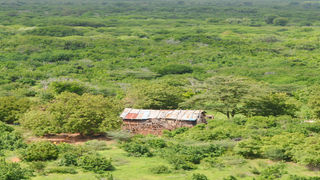
Boni Forest.
| Kevin Odit | Nation Media GroupPremium
Terrorism and tourism: Tales from the Lamu Archipelago
What you need to know:
- The list of places in Kenya that you cannot visit due to insecurity posed by the Shabaab keeps growing.
On paper, the Kiunga Marine Reserve, Dodori and Boni National reserves read like tourism destinations plucked from heaven. But they are not.
The Kenya Wildlife Service particularly describes Kiunga on its website as “a pristine ecosystem incorporating a chain of about 50 calcareous offshore islands and coral reefs in the Lamu Archipelago”.
From above, it is picturesque. Below, it is a heartless land, a dangerous jungle where marauding Al-Shabaab gangs call the shots
At times, tour agencies lure tourists here promising “nature guided walks” and that you can “come across many tree species some not recorded elsewhere in Kenya”.
They also tell visitors they will have high chances of seeing elephants and other wildlife, ‘not forgetting the bird experience’.
But that is far from truth.
In fact, the Kiunga National Reserve, plus Dodori and Boni, form part of the most dangerous places to visit in Kenya.
In a country that presents itself as the most stable in the region, the list of places you cannot visit due to insecurity posed by the Shabaab keeps growing.
National reserves
Boni and Dodori, which are both dense forests, were gazetted as national reserves in 1976. Boni, which is named after the Boni hunter tribe, is located in Garissa while Dodori, which derives its name from a river by a similar name, lies in Lamu County.
Dodori covers an area of 877 square km, while Boni comprises 1,339 square km.
The Evolutionarily Distinct and Globally Endangered (EDGE) global conservation initiative says Boni is home to five threatened plant species, the elephant shrew and insectivorous mammals native to Africa.
Yet, despite all the potential, you will never see Boni or Dodori and Kiunga on any tourism brochure. In fact, none of them has any form of accommodation. The last hotel to operate in the geographical area they occupy was Kiwayu Safari Village, a rustic luxury secluded beach lodge located in Kiwayu Island that was closed in 2011 after a British tourist was kidnapped by Al-Shabaab gunmen.
“Tourists will come again, one day. I don’t believe we have seen the end,” says Mohamed Malor, who was once a guard at Kiwayu Safari Village, located on the edge of Dodori and overlooking Kiunga.
“So many of the militants have been killed, but they never learn,” Malor says of their continuing presence in their neighbourhood. “It is like the more they are killed, others join in.”
Today, Boni is a war zone that extends into Somalia; Dodori is an inaccessible expansive bush land lying along the border with Somalia while Kiunga is a paradise waiting for the day it will be explored.
While tourists are no longer allowed to venture into Dodori and Boni, police have outlawed civilians from their vehicles.

Boni-Dondori forest in Lamu.
With a poor road network, the only available reliable form of transport are government vehicles. But after a series of attacks targeting security vehicles started in 2017, the government banned civilians from its vehicles.
“Having civilians in our vehicles means they also become a target in a war they are not taking part in,” says Lamu County Commissioner Irungu Macharia.
Pushed away from south Somalia, the Bajuni, a Swahili sub-tribe that speaks a language called Tikuu, are the last remaining original inhabitants of the vast area covering Boni, Dorori and Kiwayu island, which is surrounded by the Kiunga Marine Park.
The other little-known tribe occupying these lands are the Awer, who are also known as the Waboni who, according to the National Geographic, are “among the world’s few remaining stone-age people”.
However, three decades of insecurity in the neighbouring Somalia, plus a decade of Al-Shabaab presence, have ensured the alienation of these two tribes from taking part in national matters or making any significant contribution to the economy.
The only road that could have connected the interior of Boni with the rest of Kenya is suspected to be filled with improvised explosive devices, making it dangerous, even to the military. Thus, the edges of Dodori can only be accessed by the ocean via a three-hour boat ride from Lamu.
One of the people had already died but they still shot him in the mouth.
In essence, the communities here are trapped in the crossfire of a global war on terror. They claim the police harass them routinely when seeking information that would help in arresting extremists within their midst.
On the other hand, Al-Shabaab militants hiding in these forests have informers in the communities who monitor to see any new faces, and who are interacting with them on suspicion that they are giving out information.
We witnessed this at Kiunga where we were trailed from a distance by suspicious people while the locals appeared afraid to talk to us – apart from the routine greetings. Residents told the Nation that it is common for gunmen to raid their homes and forcefully take food and medical supplies.
Omar Mohammed, who once came face to face with the Shabaab during an attack at Marani, inside Dodori forest, described it as a scene from hell. A vehicle had been stopped and its occupants ordered out.
“One of the people had already died but they still shot him in the mouth,” he narrated of his encounter with the militants six years ago after he had ventured into the forest.
“The rest were ordered to sit down and place their knives in front of them. One of the attackers told them ‘today you are going to slaughter each other one by one,” he recalled.
Mr Mohammed, after peeping from the trees, did not wait to witness. For here, there are no witnesses.






